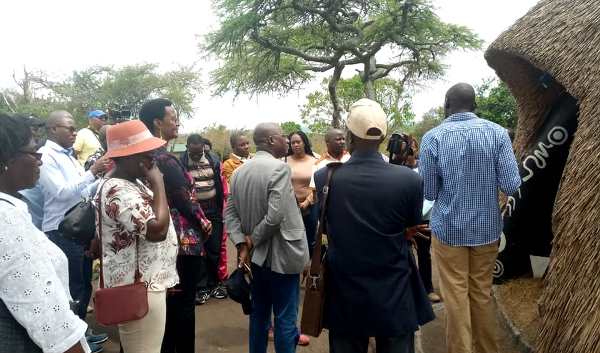All over the world as history traces back to the earlier centuries, Dictators have always based on propaganda to fuel regime motives for example; Adolf Hitler hired an individual professional photographer who captured close to 2 million snapshots of the Nazi leader, well as Joseph Stalin utilized doctored images to cease out all evidence of purged political enemies and so is not different with Uganda’s former President General Field Marshal Iddi Amin Dada who seized power in the year 1971 after a Military Coup that ousted President Apollo Milton Obote 1 who had traveled to Singapore to attend a Conference.
Iddi Amin’s eight year rule costed thousands of Ugandan civilians as they lost lives with deaths registered to more than 300,000 with a chain of brutality and events surrounded which was not so different according to earlier atrocities as historian Derek R. Peterson and anthropologist Richard Vokes write for the Conversation, government photographers were a “constant presence” in Amin’s Uganda, documenting the dictator’s public appearances and providing evidence of social issues—including smuggling and South Asians’ economic dominance—purportedly plaguing the country at the time. What the cameras largely left out, however, was the regime’s brutal treatment of those who opposed or were affected by Amin’s authoritarian policies.
Over the course of his eight years as president of Uganda Idi Amin was the subject of hundreds of thousands of photographs. A dedicated and talented team of photographers under the Ministry of Information followed Amin, taking pictures of the many occasions when he appeared before a public. It was a perilous job as one of government photographer—Jimmy Parmar— was executed by Amin’s men as punishment for his pursuit of unapproved photographic subjects.
Upon his downfall from Uganda’s Presidency, thousands of photos taken were assumed to have disappeared from the historical record as rumoured to have been destroyed during the tumult of the early 1980s or misplaced during subsequent relocations of the Ministry’s archives until of recent in the year 2015, though, researchers and archivists at the Uganda Broadcasting Corporation uncovered a filing cabinet full of thousands of photographic negatives. Each envelope was carefully labeled with information about the date and subject of the photograph. In all, there are 70,000 negatives, dating from the late 1950s to the mid-1980s. So far as we know, none of the photographic negatives in the U.B.C. archive have been published or displayed in any public venue. The vast majority of the negatives were never printed. This is, until now, an unseen archive. In January 2018 the U.B.C. launched a project to digitize this important collection. With funding and technical support from Makerere University, the University of Michigan, and the University of Western Australia, the dedicated team of archivists has digitized 25,000 images to date. ‘The Unseen Archive of Idi Amin’ consists of 200 photographs drawn from the much larger collection held by the U.B.C. All of these photographs were made to glorify President Amin, elevate the accomplishments of his presidency, and make visible the iniquities of the enemies – both real and imagined – that his government pursued. These photographs testify to the passions and enthusiasms that his government cultivated. The archive also includes many pictures of everyday public and cultural life in 1970s Uganda.
It provides a unique insight into how the Amin years were experienced by ordinary Ugandans, how people worked, played, and loved during this time. The images displayed here are unaltered and unedited. Where possible, the curators have titled the photographs using the same titles assigned by the photographers at the time the negatives were developed. There is very little in the U.B.C. photo archive that directly illustrates the awful history of violence and inhumanity in the 1970s. A great many people—as many as 300,000—died in the hands of men serving Amin’s government.
This violence, the torture and murder of dissidents, criminals, and others who innocently fell afoul of the state largely took place out of public view. It leaves no trace in the U.B.C. archive. The positive and uplifting photos in this collection mask the harsh realities of public life at this time: unaccountable violence; a collapsing infrastructure, and shortages of the most basic commodities.
As custodians have made efforts throughout this exhibition to remind you, the viewer, that for many Ugandans the 1970s were a violent, perilous time. But this archive cannot tell that story with any fluency. So we see this exhibition as a starting point, and a work-in-progress, not a final product. In future years, they hope to develop a more fully representative exhibition about the experience of ordinary Ugandans in the 1970s.
However, The exhibition is not a comprehensive exploration of all aspects of Amin’s regime. Rather it looks forward to act as a space for reflection and discussion. To support this goal, the museum has hosted a series of panels featuring individuals who lived through the dictator’s rule: politicians who served in his cabinet, Journalist journalists who wrote about his government and some of the many who lost loved ones at the hands of Amin.
The Unseen Archive
In 2015, in a forgotten filing cabinet at the headquarters of the Uganda Broadcasting Corporation (UBC), researchers discovered 70,000 photographic negatives once thought to have been destroyed.
Sorted and labeled, these were Ministry of Information images spanning the late 1950s to the mid-1980s. They chronicled high politics and everyday life in Uganda. They also documented the regime of President Idi Amin. Until now, they have been unseen by the public.
In May, the Uganda Museum in Kampala debuted The Unseen Archive of Idi Amin, an exhibition of 200 photographs from the collection.
Professor Derek Peterson (History, African and Afro-American Studies) is one of the curators. He is also helping lead an effort to digitize and preserve the photographic collection.
“There’s never been a public exhibition in Uganda about Idi Amin; neither is there a museum, or a monument, or a memorial to the time. There is no narrative around which to hang this story,” said Peterson.
“That is not to say that there’s an absence of discussion: all over the political spectrum Ugandans have been arguing over Amin’s legacy, and there’s been a number of recently published memoirs detailing authors’ experiences with Amin’s regime.”
The exhibition is part of a broader project aimed at digitizing the negatives and related radio and film recordings. Just two weeks ago, in a UBC storeroom, the team found 92 film reels of Uganda Television coverage of public events related to the Amin government.
“With the encouragement of the UBC these reels have now been transported to Ann Arbor, and we’re looking for funding to get them digitized,” said Peterson.
In 2020 the exhibit will travel to four regional museums in Uganda, and in 2021 the curators hope to take it outside of Uganda, possibly to Michigan. A documentary is also in the works. Project partners include UBC, Uganda Museum, Makerere University, U-M, and the University of Western Australia.
“As curators, we’ve had to be very sensitive about the variety of ways in which Ugandans understand and interpret the 1970s,” said Peterson. The curatorial team includes Uganda Museum’s Nelson Abiti, recent U-M Anthropology and History PhD Edgar Taylor, and University of Western Australia’s Richard Vokes.
“Our exhibition works by placing the grand images of public life-most of which are focused on Amin himself-with images of those who suffered or were killed during the 1970s. The idea is to juxtapose different kinds of historical experiences, different ways of seeing the time, so as to enable a pluralistic understanding of the past,” said Peterson.
Here are the Photos discovered in the unseen archives;


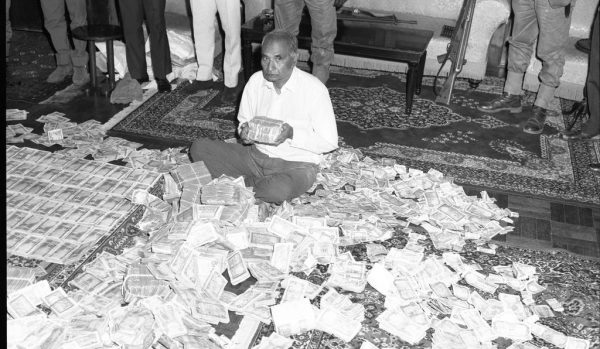
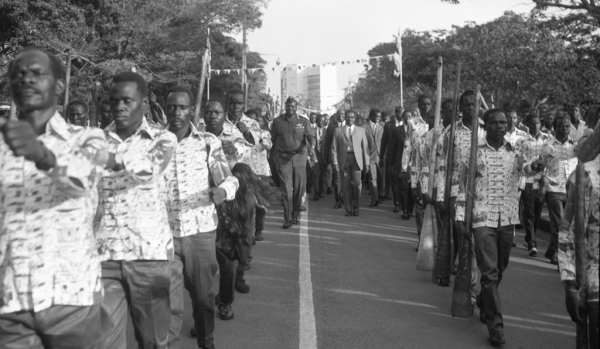
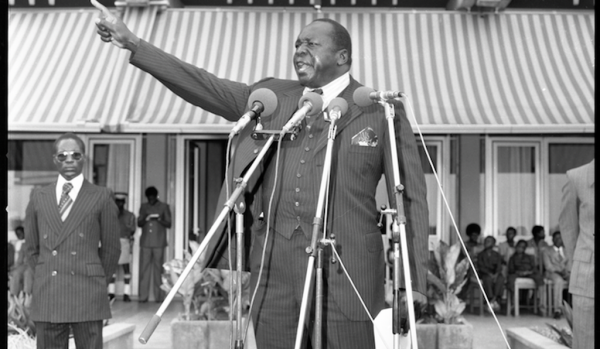

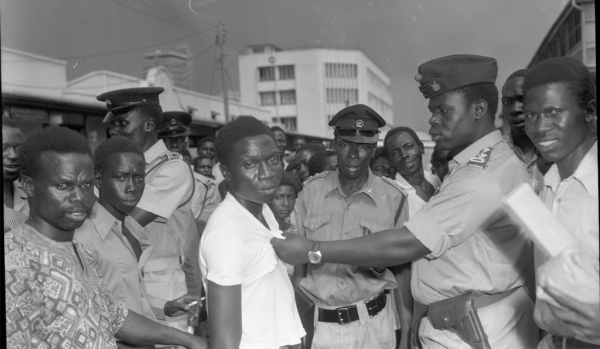


mark OAU Liberation Day at command post Kololo
25 May 1974 UBC 3987-002
About Guide2Uganda
Guide2Uganda (www.guide2uganda.ug) is the most comprehensive source of information about Uganda that exists on the web, with more content on Uganda and surrounding towns, attractions, museums and galleries than any other online guide that currently exists for Uganda as well as being a dynamic news and comprehensive events driven site with content being added daily.
According to WeFollow & Peer Index (whom both measure online influence) we are among the most influential online media organizations in Uganda. We were also awarded for ‘’Best Destination Website in Uganda’’ by Jumia Travel Uganda in the 2017-2018 Africa Travel Awards. If you are planning a visit to Uganda you can always reach us on; info@guide2uganda.ug



